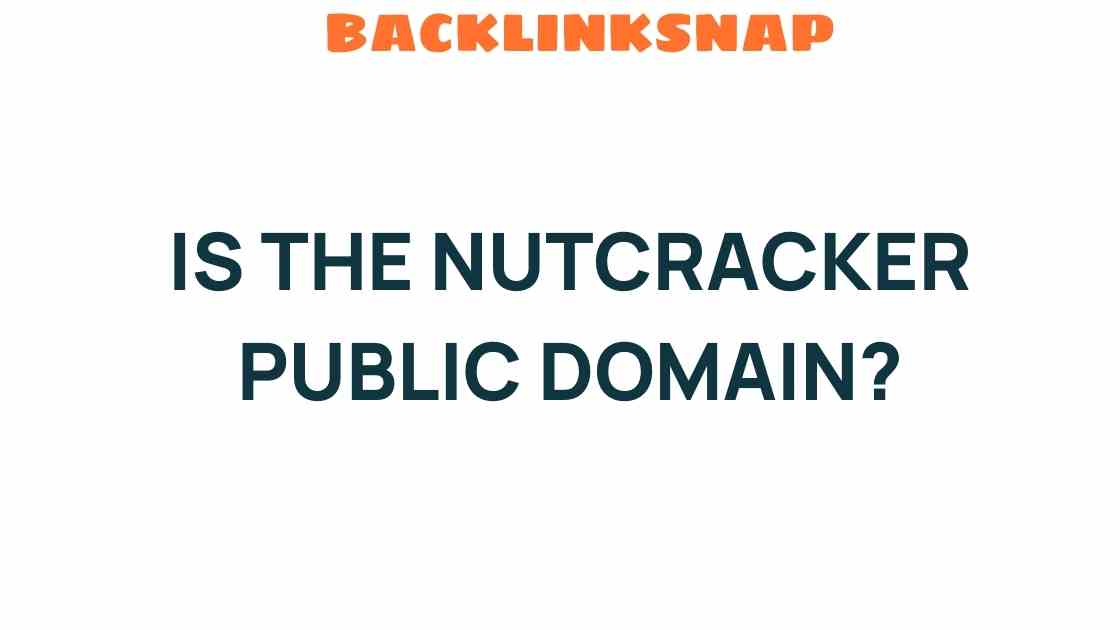Is The Nutcracker Public Domain? Unveiling the Legal Mysteries
The Nutcracker, a timeless ballet composed by Pyotr Ilyich Tchaikovsky, has become a staple of holiday traditions worldwide. Yet, beneath its enchanting melodies and whimsical choreography lies a labyrinth of legal questions about copyrights, public domain, and intellectual property. This article aims to unravel these legal mysteries surrounding The Nutcracker, providing clarity on its status in the public domain and how it impacts performances, adaptations, and the broader realm of classical music and artistic works.
The Origins of The Nutcracker
The Nutcracker premiered in 1892 at the Mariinsky Theatre in St. Petersburg, Russia. Based on E.T.A. Hoffmann’s story “The Nutcracker and the Mouse King,” Tchaikovsky transformed this tale into a magnificent ballet, featuring memorable characters like Clara, the Sugar Plum Fairy, and the Nutcracker Prince. Tchaikovsky’s score, with its delightful melodies, has captivated audiences for over a century, establishing The Nutcracker as an essential part of the ballet canon.
Understanding Copyright and Public Domain
To delve into whether The Nutcracker is in the public domain, we need to understand a few key concepts: copyright and public domain. Copyright is a form of intellectual property protection granted to the creators of original works, allowing them to control the use and distribution of their creations. In contrast, when a work enters the public domain, it becomes free for anyone to use without seeking permission or paying royalties.
The Nutcracker’s Copyright Status
As of now, the original score by Tchaikovsky is indeed in the public domain. Works published before 1923 are generally considered to be in the public domain in the United States. Since Tchaikovsky passed away in 1893 and his work was published shortly thereafter, the music from The Nutcracker can be freely performed, recorded, and adapted.
Legal Rights and Adaptations
Even though Tchaikovsky’s score is in the public domain, it’s crucial to note that adaptations of The Nutcracker—such as choreographies, scripts, and modern interpretations—may still be under copyright protection. Each choreographer or director who creates a new version of the ballet may hold the rights to their interpretation. Therefore, while the music itself can be used freely, the specific way it is presented on stage could still be protected under copyright laws.
- Public Domain Works: The original music and choreography from the first performances.
- Copyrighted Works: Modern choreographic interpretations and unique adaptations.
Classical Music and Artistic Works in the Public Domain
The status of The Nutcracker exemplifies a broader trend in classical music and artistic works. Many compositions from the Romantic era and earlier are now in the public domain, allowing performers and creators to reinterpret and share these works without legal restrictions. This accessibility fuels creativity and innovation in the arts, enabling new generations to connect with these timeless pieces.
Moreover, orchestras and ballet companies benefit greatly from the public domain status of classical compositions. They can perform works like The Nutcracker with fewer financial constraints, allowing for more elaborate productions and broader audience reach. This democratization of classical music fosters a vibrant artistic community and encourages cultural exchange.
The Global Perspective on Public Domain
While The Nutcracker is in the public domain in the United States, it’s essential to consider the global context. Copyright laws vary by country, and the duration of copyright protection can differ significantly. For instance, in many European countries, the copyright term lasts for the life of the author plus 70 years. Since Tchaikovsky died in 1893, his works entered the public domain in most of these jurisdictions well before the U.S. However, adaptations and specific performances may still be subject to different copyright laws depending on the country.
FAQs About The Nutcracker and Public Domain
1. Can I perform The Nutcracker without paying royalties?
Yes, you can perform Tchaikovsky’s original score of The Nutcracker without paying royalties since it is in the public domain. However, be cautious about any specific adaptations that may still be under copyright.
2. Are all versions of The Nutcracker public domain?
No, while Tchaikovsky’s original music is public domain, any modern choreography or unique adaptations may still be copyrighted.
3. How can I find public domain versions of The Nutcracker?
You can find public domain scores through music libraries, online repositories, or classical music platforms that specialize in offering free resources.
4. What about recordings of The Nutcracker?
Recordings of The Nutcracker may be copyrighted, especially if they are recent. Always check the specific recording’s copyright status before using it.
5. Can I create my own adaptation of The Nutcracker?
Yes, you can create your own adaptation using Tchaikovsky’s score, but ensure that your choreography or script is original to avoid copyright issues with existing adaptations.
6. How does the public domain benefit artists and performers?
The public domain allows artists and performers to access and reinterpret classical works freely, fostering creativity and making art more accessible to everyone.
Conclusion
In conclusion, The Nutcracker is indeed in the public domain, allowing its enchanting music to be enjoyed and explored by all. However, as with many works of art, the adaptations and specific performances may still be bound by copyright laws. Understanding these nuances is essential for performers, choreographers, and anyone involved in the arts. By embracing the public domain, we can celebrate Tchaikovsky’s legacy and ensure that his brilliant compositions continue to inspire and delight audiences for generations to come. For further reading on copyright and public domain, you might explore resources from the Cornell Law School.
This article is in the category Digital Marketing and created by BacklinkSnap Team




